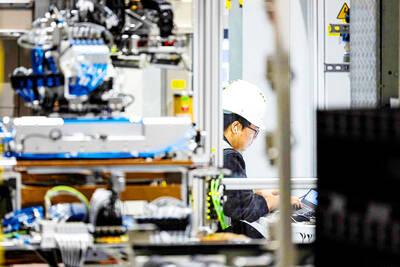The euro soared close to its all-time high against the dollar in London on Friday on the last day of a year in which it gained 8.5 percent on a steadily weakening greenback.
The euro in afternoon trading was at US$1.3635 against US$1.3634 in New York late on Thursday. The single European currency at one point shot up to US$1.3661, just shy of the record US$1.3666 set on Thursday. The dollar was meanwhile at ¥102.53 after ¥103.4 on Thursday.
The euro is now 8.5 percent stronger against the dollar than it was a year ago and by most accounts it could climb still higher in the new year.
The trend has alarmed some European political leaders who fear that an appreciating euro will reduce the competitiveness of eurozone exports and threaten what is already a fragile recovery in the 12-nation zone.
Many analysts suspect that the Bush administration, despite its stated preference for a strong dollar, is in fact not unhappy with the dollar's slide, seeing it at as a means to boost US exports and thereby shrink the country's massive current account deficit.
The dollar could nonetheless see a degree of consolidation in the New Year after recent sharp movements. The euro has risen three percent against the greenback since Dec. 15.
But Neil Mellor of the Bank of New York said most traders were likely to be happy with the euro trading around the US$1.36 level, with the dollar broadly poised to continue its downward trend.
"All roads point south for the dollar," he said.
The yen is also likely to to edge ever higher against the US currency, although the possibility of intervention by the Bank of Japan to weaken the dollar will mean it will trade within a tighter range than the euro-dollar rate.
The euro was changing hands at US$1.3635 against US$1.3634 late on Thursday in New York, ¥139.74 (¥140.53), £0.7068 (£0.7078) and 1.5437 Swiss francs (SF1.5434). The dollar was at ¥102.53 (¥103.04) and SF1.1321 (SF1.1314).
The pound stood at US$1.9296 (US$1.9254), ¥197.82 (¥198.47) and SF2.1846 (SF2.1780).

CHIP RACE: Three years of overbroad export controls drove foreign competitors to pursue their own AI chips, and ‘cost US taxpayers billions of dollars,’ Nvidia said China has figured out the US strategy for allowing it to buy Nvidia Corp’s H200s and is rejecting the artificial intelligence (AI) chip in favor of domestically developed semiconductors, White House AI adviser David Sacks said, citing news reports. US President Donald Trump on Monday said that he would allow shipments of Nvidia’s H200 chips to China, part of an administration effort backed by Sacks to challenge Chinese tech champions such as Huawei Technologies Co (華為) by bringing US competition to their home market. On Friday, Sacks signaled that he was uncertain about whether that approach would work. “They’re rejecting our chips,” Sacks

NATIONAL SECURITY: Intel’s testing of ACM tools despite US government control ‘highlights egregious gaps in US technology protection policies,’ a former official said Chipmaker Intel Corp has tested chipmaking tools this year from a toolmaker with deep roots in China and two overseas units that were targeted by US sanctions, according to two sources with direct knowledge of the matter. Intel, which fended off calls for its CEO’s resignation from US President Donald Trump in August over his alleged ties to China, got the tools from ACM Research Inc, a Fremont, California-based producer of chipmaking equipment. Two of ACM’s units, based in Shanghai and South Korea, were among a number of firms barred last year from receiving US technology over claims they have

It is challenging to build infrastructure in much of Europe. Constrained budgets and polarized politics tend to undermine long-term projects, forcing officials to react to emergencies rather than plan for the future. Not in Austria. Today, the country is to officially open its Koralmbahn tunnel, the 5.9 billion euro (US$6.9 billion) centerpiece of a groundbreaking new railway that will eventually run from Poland’s Baltic coast to the Adriatic Sea, transforming travel within Austria and positioning the Alpine nation at the forefront of logistics in Europe. “It is Austria’s biggest socio-economic experiment in over a century,” said Eric Kirschner, an economist at Graz-based Joanneum

France is developing domestic production of electric vehicle (EV) batteries with an eye on industrial independence, but Asian experts are proving key in launching operations. In the Verkor factory outside the northern city of Dunkirk, which was inaugurated on Thursday, foreign specialists, notably from South Korea and Malaysia, are training the local staff. Verkor is the third battery gigafactory to open in northern France in a region that has become known as “Battery Valley.” At the Automotive Energy Supply Corp (AESC) factory near the city of Douai, where production has been under way for several months, Chinese engineers and technicians supervise French recruits. “They